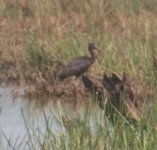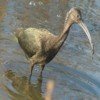tomjenner
Well-known member
I need some help to confirm the identification of some dark Ibises that I saw last week at El Jicarito in southern Honduras. I am already pretty sure that I know what they are, but I would really like the opinion of some people who are familiar with these species (I have only ever seen one Glossy Ibis, 20 years ago, and I have never seen a White-faced Ibis) and I would rather they weren't influenced by my thoughts. The photos are pretty poor, but at least show that they are either Glossy or White-faced Ibis. Neither species has ever been reported in Honduras before, so I need to get my identification 100% correct. An unidentified dark Ibis was once seen in the northern part of the country which was thought to be Glossy ibis (based on location) even though the features suggested White-faced. This has been the general thinking to date, that if a bird was seen on the Pacific coast it would probably be a White-faced and on the Caribbean slope it would probably be a Glossy. However, recent sightings in neighbouring El Salvador (Pacific coast) have been Glossy Ibises, so it is evident that location is totally unreliable.
I saw a distant group of 94 individuals, then a closer sighting of a single individual and another of 8 individuals. My descriptions come from these 9 birds.
Description
Single bird
The long decurved bill was a pale horn colour throughout. The legs were a reddish horn colour and the eye was dark, without any hint of red colouration.
This bird had a deep purplish brown colour all over the head, body and wings, with a green sheen to the coverts. There were thin white streaks over the head and down the neck, but not all the way to the body.
There was a thin, but distinct, white line over the top of the base of the bill and back over the dark lores to the top of the eye. Another, similar, line formed a malar stripe under the lores from the base of the lower mandible to the bottom of the eye. The white did not continue around the back of the eye. The exact colour of the lores could not be determined, they appeared dark grey or brown, though not black. It was clearly not red, though no blue colouration could be seen either (though both of these colourations would only be expected in summer/alternate plumage birds).
Group of 8
The birds were noticeably smaller than the white Ibises nearby. Some had faint white borders to the lores, but some were much more distinct. The more weakly marked birds had no green on the plumage and were a duller brown colour. None of these birds had red eyes (though juvenile White faced Ibises would not get their red eyes until about January). The eye colours of other species (eg Cattle Egret and White Ibis) nearby could easily be seen indicating that the viewing conditions were not limiting the observation of this feature.
Identification
I have found slightly contradictory comments on the internet, but it seems that the white bordering to the lores, leg colour, eye colour, lore colour and accurate aging of the birds is the key to the separation of these species.
I would really appreciate your help in this.
Tom
I saw a distant group of 94 individuals, then a closer sighting of a single individual and another of 8 individuals. My descriptions come from these 9 birds.
Description
Single bird
The long decurved bill was a pale horn colour throughout. The legs were a reddish horn colour and the eye was dark, without any hint of red colouration.
This bird had a deep purplish brown colour all over the head, body and wings, with a green sheen to the coverts. There were thin white streaks over the head and down the neck, but not all the way to the body.
There was a thin, but distinct, white line over the top of the base of the bill and back over the dark lores to the top of the eye. Another, similar, line formed a malar stripe under the lores from the base of the lower mandible to the bottom of the eye. The white did not continue around the back of the eye. The exact colour of the lores could not be determined, they appeared dark grey or brown, though not black. It was clearly not red, though no blue colouration could be seen either (though both of these colourations would only be expected in summer/alternate plumage birds).
Group of 8
The birds were noticeably smaller than the white Ibises nearby. Some had faint white borders to the lores, but some were much more distinct. The more weakly marked birds had no green on the plumage and were a duller brown colour. None of these birds had red eyes (though juvenile White faced Ibises would not get their red eyes until about January). The eye colours of other species (eg Cattle Egret and White Ibis) nearby could easily be seen indicating that the viewing conditions were not limiting the observation of this feature.
Identification
I have found slightly contradictory comments on the internet, but it seems that the white bordering to the lores, leg colour, eye colour, lore colour and accurate aging of the birds is the key to the separation of these species.
I would really appreciate your help in this.
Tom





